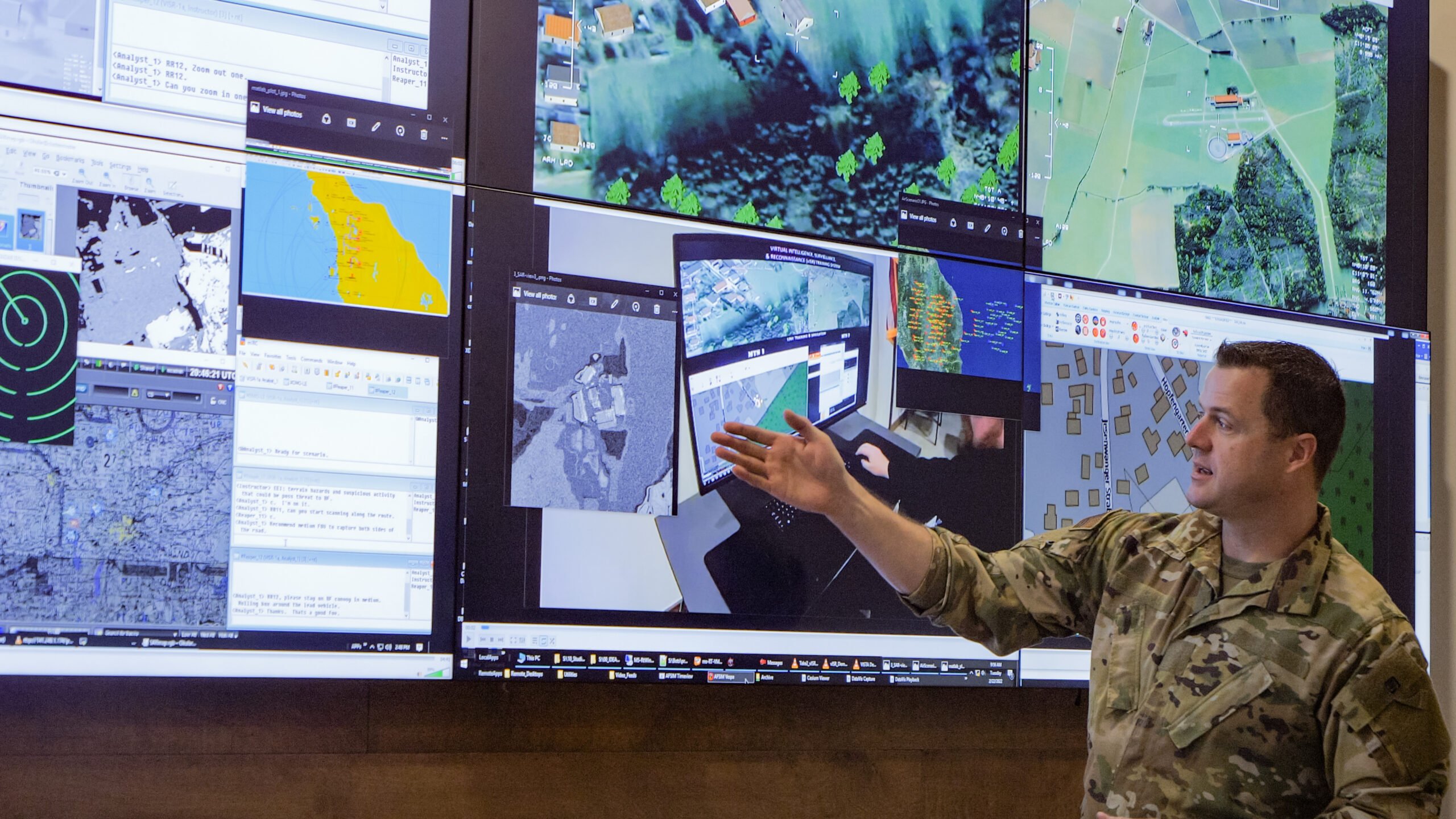
CAE VISTA can create essentially any C2ISR platform in the virtual space. Photo courtesy of CAE.
In this Q&A with Matt “Killjoy” Martin, director, Advanced Solutions Strategy at CAE USA, we discuss how the CAE Virtual Intelligence Surveillance & Reconnaissance Training Application (VISTA) generates synthetically the same type of data that warfighters would get from training with live ISR assets during actual operations.
Breaking Defense: What is the threat scenario today as it relates to the need for virtual training on ISR systems? How has this sort of training been done up until today?

Matt “Killjoy” Martin is director of Advanced Solutions Strategy at CAE USA.
Martin: The threat scenario we are focused on at CAE is the high-end, sophisticated, threat-contested environment where you would expect sophisticated air defense systems, electronic warfare, and rapid targeting of all-domain blue forces. The DoD and their allies are up against a very sophisticated threat environment.
In the past, the intelligence apparatus in the Air Force and other services was focused on the lower-end – the counterterrorism, counterinsurgency fight where the intelligence analysts support special operations task forces to hunt down specific high-value targets.
Training was focused on the operational level of C2ISR: intelligence analysis, targeting, operational command and control. Centralized intelligence centers called DCGSs, distributed common ground stations, received data from many ISR platforms and sensors. Through a process of exploitation that fuses the data, assessments are made and intelligence products are produced to support their different customers.
In the past, it was primarily learned through on the job training, partly because there was always a need to get people into action, to start assessing these huge quantities of data, and also because the capability to replicate that type of data-immersive environment did not exist. The best training was on-the-job training with an instructor over the shoulder.
It’s a different threat environment now. We are faced with the erosion of the U.S. as a dominant military world power as adversarial nations develop and acquire equivalent weapons, becoming near-peer threats. Now warfighters are challenged with training in a world that includes advanced electronic warfare, contested environments, and hypersonics.
This makes training difficult, because until conflict actually breaks out, there is no on-the-job training to be done. The type of live data from 20 years of operations in Iraq and Afghanistan is not available.
CAE has developed a data-centric virtual environment to satisfy that level of training. VISTA can create essentially any C2ISR platform in the virtual space. High-fidelity, high-resolution models of virtual sensors can be attached to those platforms, as well as emitters, radios, and weapons, which synthetically generate the same type of data that you would be getting from live ISR assets if there was an actual operation.
Data can be streamed onto operational networks, stimulate the processes that are utilized, along with the software tools, the process of exploitation, analysis, and producible intel products, to allow them to do their job as if there were live operations, but all in a virtual environment. This means they can create whatever scenarios and threats they want; they can get to a level of complexity that is hard to achieve through any type of live training.
Since on-the-job training for these scenarios is not feasible, analysts have had to go TDY to participate in a Red Flag or Virtual Flag exercises, and those opportunities are not plentiful enough to build up the capacity that we need. CAE VISTA provides the capability to do that at the local level and to a high level of complexity, increasing repetition and expertise.
Breaking Defense: What does the VISTA training environment look like?
Martin: At its heart, CAE Vista is a synthetic data-generation tool that lets you use whatever interfaces and software tools you would normally use to do your mission, ideally from your operational intel cell. If you were in an Air Force DCGS at Hickam or Langley or Ramstein, that’s where you would do your training – at the point of need. You do the training on your own operational terminals using the same software tools you use every day to complete your mission.
It’s like flipping the switch on the intel cell to training mode, and then streaming all of this synthetic data from these virtual platforms onto your network and going about your business. It’s as completely as immersive as live operations and at the same level of fidelity.
Breaking Defense: Tell us about the training programs you’re doing with the US Air Force Distributed Mission Operations Center [DMO] at Kirtland Air Force Base and others?
Martin: One of the big challenges that has been impeding the scalability of DMO-type events in the past has been the digital infrastructure that legacy DMO systems use. The Air Force DMO network is a separate standalone training network that requires a lot of testing because there are no common cybersecurity standards for connecting different training devices. That makes it difficult to keep training systems concurrent with the weapon systems that you’re supposed to represent.
It’s a legacy approach of taking big training systems with their own standalone footprints, hardware and software, and connecting them through an interoperability standard like Distributed Interactive Simulation [DIS], an IEEE standard, to try to correlate the training experiences.
If I’m in my F-16 simulator and I’m trying to interact with an AWACS simulator, each independently creates the simulation events. We try to correlate their experiences with DIS and hope they are seeing the same things at the same time. It’s a limiting approach.
To address that, CAE is poised as the prime on a program called SCARS, Simulator Common Architecture Requirements and Standards. This is building out the training cloud for the US Air Force, which will eventually encompass all 2,400+ training systems across 300 locations in the Air Force. The initial task order covers nine sites and integrates new standards into the A-10 and KC-135 platforms.
It is a hybrid-cloud architecture approach whereby there is centralized management of cybersecurity, scanning and patching of training systems and virtualization of those training systems to enable computation via the cloud architecture. This will change the way the Air Force approaches distributed training. The SCARS enterprise system enables fair-fight commonality at the highest fidelity and unlocks huge savings and benefits.
In anticipation, we have already virtualized CAE VISTA as an app on the cloud architecture. If you’re at your training location and want to add the C2ISR capability to your current training systems as part of the SCARS network VISTA becomes an app that allows you to download onto your local architecture and rapidly add that capability. You don’t have to have a separate rack of computers or your own dedicated hardware. It’s designed to run on the on-premise equipment that’s already part of the SCARS architecture.
Breaking Defense: You use a hybrid-cloud architecture for CAE VISTA. Explain its value.
Martin: A great thing about the hybrid-cloud approach to SCARS is that it enables common authoritative data sources. This capability is going to be very useful to JSE, the Joint Simulation Environment, where efforts to conduct fifth and sixth-gen training is at a very high level of resolution. It’s important to have the same classified threat models, the same classified weapons models, the full performance of those fifth and sixth-gen platforms represented in all of the trainers that are networked together to effectively do this combined training.
One of the game-changing capabilities of SCARS is the common authoritative data digital architecture. To get to the point where different training systems can draw from the same authoritative data sources, they have to be part of a digital architecture that enables access to data that is centrally managed. CAE VISTA will access the SCARS common authoritative data sources and then create high-resolution, high-fidelity synthetic data as part of complex scenarios to simulate all of the operational-level processes that drive the tactical action of those fifth and sixth-gen players.
It enables the Air Force to take tactical training, integrate it with the operational level, and work through all the problems of coordination, tasking, and targeting – with everybody playing in the same digital sandbox.
Breaking Defense: How will CAE VISTA help to enable all-domain operations?
Martin: Taking a capability we developed over the last number of years using our own internal investment in anticipation of these needs, CAE is also developing prototype software that enables simulation of current and future capabilities operating across a multi-domain environment. The software will simulate a range of capabilities and threats to include physical and digital environments that the Air Force DMO White Force Cell would normally have to replicate themselves or provide verbal/written injects to the training audience.
They sometimes need more than 100 White Cell players just to create all of this content complexity in the scenario. Leveraging AI tools, we are able to automate and reduce the footprint of the White Cell players required, which results in tremendous savings for the Air Force. The prototype software will enable the White Force Cell to free up limited personnel resources and create more realistic interactive combat scenarios.
Utilizing CAE VISTA data, CAE has also supported the last four BoldQuest exercises for the Joint Staff J6. The exercise focuses on proving out different concepts for JADC2. We anticipate continuing to support that in the next few years.
Breaking Defense: Final thoughts?
Martin: We now have the capability to immerse operational-level players in this complex data environment. Whatever processes needed for training or rehearsal at the operational level, we can enable. In an immersive virtual environment you are able to go through any processes and scenarios needed.
Second, this is fully compatible and easy to integrate with the tactical level, whether it’s live or virtual training operations. Tactical players can combine with operational-level players, a task that has been very difficult to do in the past.
Third, this is software. Because of the cloud architecture, it’s easy to scale, easy to sustain, very cost effective, and allows you to get at these problems across the entire enterprise without having to send anybody TDY or put together the time and expense of a live exercise. CAE’s virtualized data on SCARS enables advanced training with access and manipulation of common high-fidelity data, and delivers rapid systems and visualization to the warfighters depending on accuracy for their mission readiness.





















